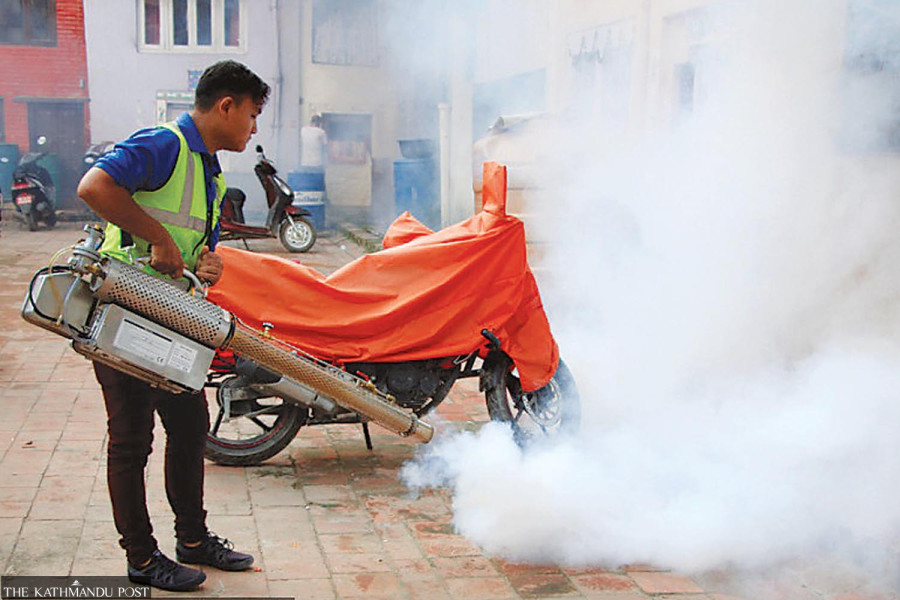Health
Budget cuts by government and donors hinder Nepal’s fight against malaria
As temperature rises, the malaria-transmitting mosquito shifts to hills and mountains, risking outbreaks in areas considered non-endemic in the past.
Arjun Poudel
Forty-six out of 77 districts throughout the country reported infection of malaria since the start of 2023. Most of the districts, which reported malaria cases, are from hilly and mountainous regions, according to officials at the Epidemiology and Disease Control Division, an agency responsible for containing diseases.
“Vectors transmitting malaria have shifted to hills and mountains,” said Dr Gokarna Dahal, chief of the Vector Control Section at the division. But the agencies working in the field lack sufficient budget even to carry out vector surveillance, according to him. “Moreover, the budget for the purpose has now been slashed not only by the government but also by the aid agencies,” he said.
Malaria is caused by Plasmodium parasites. Infected female Anopheles mosquitoes carry these deadly parasites, according to the World Health Organisation.
Nepal is among the UN health body’s E-2025 member countries that have the potential to eliminate the disease by 2025. In April 2021, the UN health agency launched the E-2025 initiative to halt malaria transmission in 25 identified countries by 2025. The government has also committed to meeting the deadline.
To earn the ‘malaria-free’ status in 2026, Nepal needs to bring down indigenous cases or local transmission of the disease to zero, and zero deaths from 2023, and sustain zero cases for three consecutive years, according to the World Health Organisation.
So far, 113 cases of Malaria infection have been reported since the start of 2023. Of them 110 are imported cases and three are reported to be indigenous.
Officials at the division said that they have been studying the three cases, which are reported to be indigenous.
According to officials, the Ministry of Health and Population had allocated Rs104.6 million federal budget for the vector control programme, which also includes the malaria control programme in the ongoing fiscal year.
But for the upcoming fiscal year’s budget, officials have been asked to limit the budget for the vector control programme at Rs64 million.
The government presents the annual budget in parliament on Jestha 15 every year as per Nepali calendar (May 29 this year). As the National Planning Commission is preparing the budget for next fiscal year, it has fixed budget ceilings for the ministries and government agencies. They have to seek topic-wise funds not exceeding the limit.
The government had already downsized the total budget by a substantial 13.59 percent totalling Rs243.83 billion for the ongoing fiscal year 2022-23 citing a plunge in revenue collection. According to officials, it is the largest cut in the ministry's outlay to date. The government cited its inability to ensure necessary funding for the cut.
Officials say it is for the first time since the fiscal year 1967-68 that the country has witnessed negative growth in revenue collection during the first six months of the fiscal year.
Along with the government, the Global Fund also provides funds for the malaria elimination programme. But with a decline in malaria cases, the fund has also reduced its investment in Nepal. According to officials, in the last three years, the Fund invested US$4 million in the malaria control programme. But the Fund reduced its three-year budget to start from 2024 to US$3.1 million, officials said.
“After reaching a tipping point, it will be very difficult to lessen disease burden,” said Professor Murari Das, an entomologist at the BP Koirala Institute of Health Sciences. “Additional efforts and resources are needed. If we still say we will bring down malaria cases to zero by reducing the budget significantly it will be unrealistic.”
Officials at the Health Ministry said that they could not carry out sufficient testing and distribute insecticide-treated bed nets in high-risk areas due to a budget crunch.
According to them, the plan was to procure 180,000 lasting insecticide-treated bed nets for the ongoing fiscal year, but only 120,000 nets were purchased. The division had planned to buy 500,000 malaria testing rapid diagnostic kits for the ongoing fiscal year but it purchased only 315,000 kits.
Distribution of insecticidal nets in the affected areas, and testing of the suspected cases are among the measures considered instrumental to preventing an outbreak of the deadly disease, experts say.
The health ministry purchases such nets for distribution among the residents of the areas where malaria cases are detected. Two persons in each household get an insecticide-treated bed net and when a woman of a particular house becomes pregnant she gets a separate net too. Single women and women whose husbands are away for employment get separate nets.
Das said that the vector of malaria has already reached the hills and mountain regions from Tarai, due to global warming and other factors that posed new challenges to authorities concerned. Malaria has been reported even in the mountainous districts such as Mugu, Bajura and Humla which were considered non-endemic in the past.
Officials at the health ministry said that until now Plasmodium Vivax, a protozoan parasite, was responsible for most of the malaria cases in the country, which causes relatively less severe disease. However, cases of Plasmodium falciparum, which most often cause severe and life-threatening malaria, have been rising. The parasite is very common in many countries in Africa and the Sahara desert.
Health Ministry officials said that of the total imported cases, 87 percent are from India and the rest are from various African countries.
In 2022, a total of 1,566 malaria cases were diagnosed in Sudurpaschim province, 157 in Lumbini, 42 in Karnali, 69 in Madhesh, 49 in Bagmati, 19 in Gandaki and 15 in Koshi province. Infections have been reported from 51 of the 77 districts across the country.




 19.12°C Kathmandu
19.12°C Kathmandu














